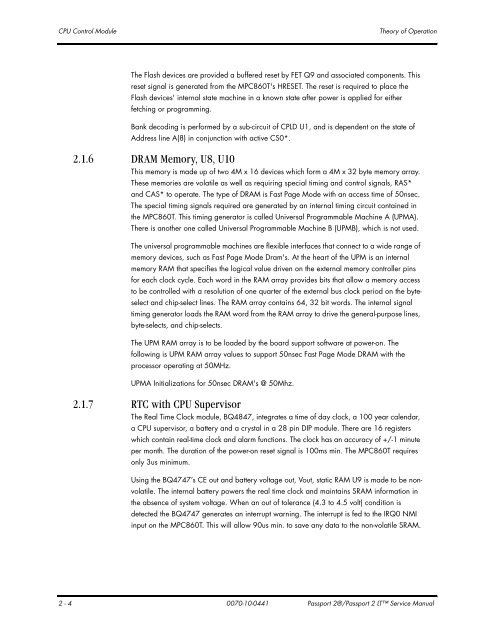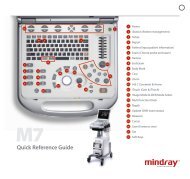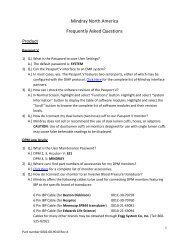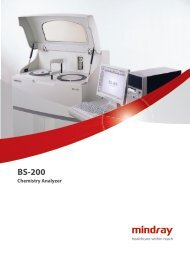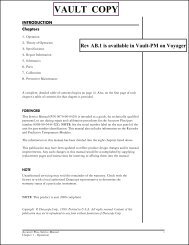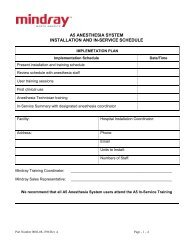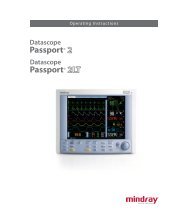Datascope Passport - Mindray
Datascope Passport - Mindray
Datascope Passport - Mindray
Create successful ePaper yourself
Turn your PDF publications into a flip-book with our unique Google optimized e-Paper software.
CPU Control Module Theory of Operation<br />
The Flash devices are provided a buffered reset by FET Q9 and associated components. This<br />
reset signal is generated from the MPC860T's HRESET. The reset is required to place the<br />
Flash devices' internal state machine in a known state after power is applied for either<br />
fetching or programming.<br />
Bank decoding is performed by a sub-circuit of CPLD U1, and is dependent on the state of<br />
Address line A(8) in conjunction with active CS0*.<br />
2.1.6 DRAM Memory, U8, U10<br />
This memory is made up of two 4M x 16 devices which form a 4M x 32 byte memory array.<br />
These memories are volatile as well as requiring special timing and control signals, RAS*<br />
and CAS* to operate. The type of DRAM is Fast Page Mode with an access time of 50nsec.<br />
The special timing signals required are generated by an internal timing circuit contained in<br />
the MPC860T. This timing generator is called Universal Programmable Machine A (UPMA).<br />
There is another one called Universal Programmable Machine B (UPMB), which is not used.<br />
The universal programmable machines are flexible interfaces that connect to a wide range of<br />
memory devices, such as Fast Page Mode Dram's. At the heart of the UPM is an internal<br />
memory RAM that specifies the logical value driven on the external memory controller pins<br />
for each clock cycle. Each word in the RAM array provides bits that allow a memory access<br />
to be controlled with a resolution of one quarter of the external bus clock period on the byteselect<br />
and chip-select lines. The RAM array contains 64, 32 bit words. The internal signal<br />
timing generator loads the RAM word from the RAM array to drive the general-purpose lines,<br />
byte-selects, and chip-selects.<br />
The UPM RAM array is to be loaded by the board support software at power-on. The<br />
following is UPM RAM array values to support 50nsec Fast Page Mode DRAM with the<br />
processor operating at 50MHz.<br />
UPMA Initializations for 50nsec DRAM's @ 50Mhz.<br />
2.1.7 RTC with CPU Supervisor<br />
The Real Time Clock module, BQ4847, integrates a time of day clock, a 100 year calendar,<br />
a CPU supervisor, a battery and a crystal in a 28 pin DIP module. There are 16 registers<br />
which contain real-time clock and alarm functions. The clock has an accuracy of +/-1 minute<br />
per month. The duration of the power-on reset signal is 100ms min. The MPC860T requires<br />
only 3us minimum.<br />
Using the BQ4747’s CE out and battery voltage out, Vout, static RAM U9 is made to be nonvolatile.<br />
The internal battery powers the real time clock and maintains SRAM information in<br />
the absence of system voltage. When an out of tolerance (4.3 to 4.5 volt) condition is<br />
detected the BQ4747 generates an interrupt warning. The interrupt is fed to the IRQ0 NMI<br />
input on the MPC860T. This will allow 90us min. to save any data to the non-volatile SRAM.<br />
2 - 4 0070-10-0441 <strong>Passport</strong> 2®/<strong>Passport</strong> 2 LT Service Manual


